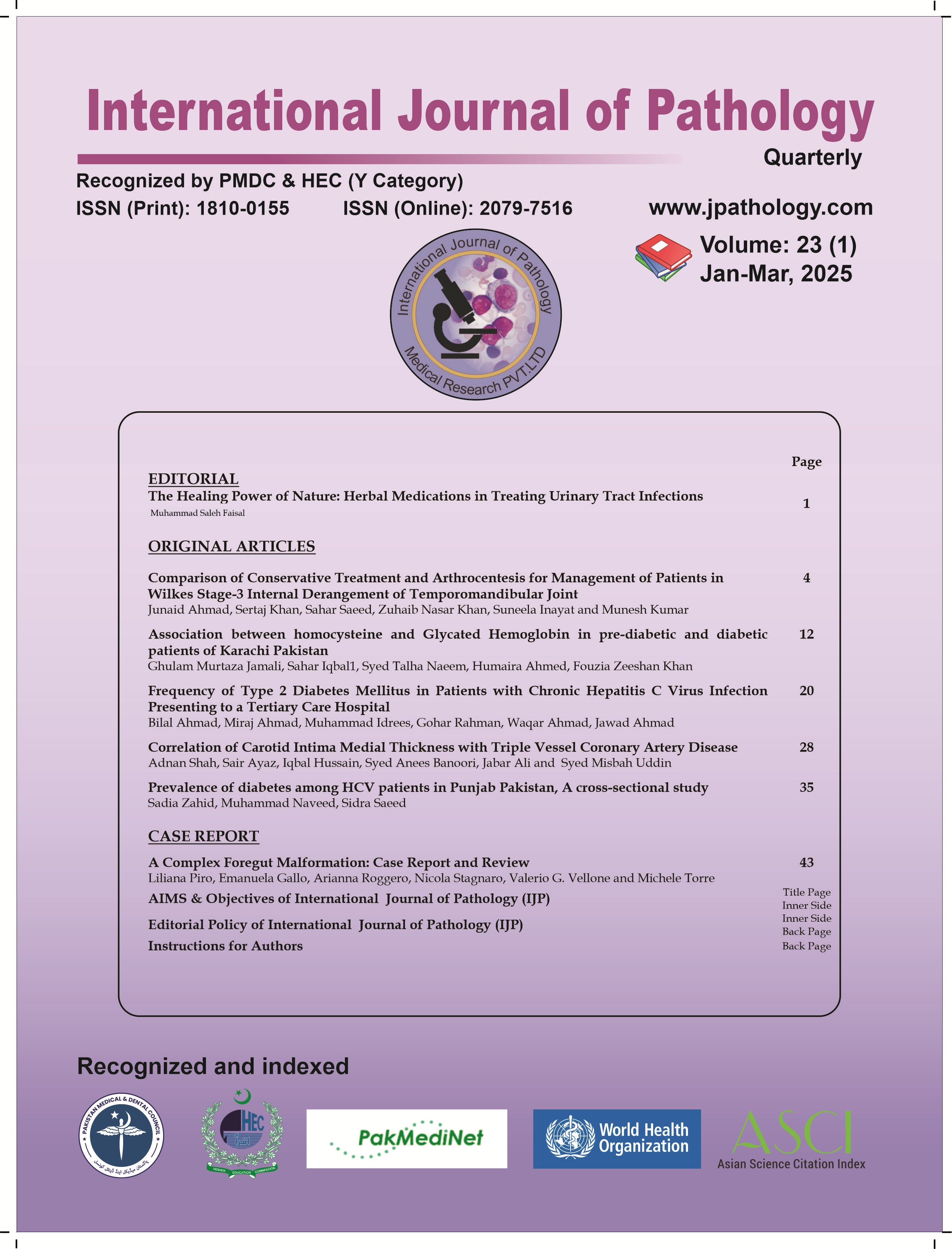Frequency of type 2 diabetes mellitus in patients with chronic hepatitis C virus infection presenting to a tertiary care hospital
DOI:
https://doi.org/10.59736/IJP.23.01.938Keywords:
Chronic Hepatitis C, Cirrhosis, Hepatitis C Virus, Insulin Resistance, Obesity, Type 2 Diabetes MellitusAbstract
Background: Chronic Hepatitis C Virus (HCV) infection poses significant public health challenges, not only due to its hepatic-related complications but also its association with metabolic disorders including Type 2 Diabetes Mellitus (T2DM). Understanding the frequency and contributing factors of T2DM in HCV patients is crucial for improving diagnosis, treatment, and outcomes
Methods: This prospective study was conducted at the Medical Unit of Lady Reading Hospital, Peshawar Pakistan, from April to September 2021. A total of 200 HCV-seropositive patients aged 18–75 years were included. The diagnosis of HCV was confirmed through ELISA, and T2DM was determined based on HbA1c levels. Data on demographics, clinical parameters, and laboratory findings were collected. Statistical analysis was done which included univariate and multivariate logistic regression, to identify significant predictors of T2DM.
Results: The prevalence of T2DM among HCV-seropositive patients was 37%. Key risk factors for T2DM included cirrhosis (OR = 2.005, 95% CI: 1.15–3.43), age ≥40 years, obesity, male gender, and a family history of diabetes (P < 0.05). Patients with cirrhosis had a significantly higher prevalence of T2DM, especially those aged >60 years. Overall, 61% of participants were overweight, 19% were obese, and 20% had normal BMI. Multivariate analysis highlighted cirrhosis and metabolic factors as significant contributors to T2DM risk.
Conclusion: T2DM is highly prevalent among chronic HCV patients, particularly those with older age, having liver cirrhosis, obesity, and a family history of diabetes. Early screening and integrated management of metabolic and liver-related complications are essential for improving patient outcomes.
References
Mohamed AA, Elbedewy TA, El-Serafy M, El-Toukhy N, Ahmed W, Ali El Din Z. Hepatitis C virus: A global view. World J Hepatol. 2015 Nov 18;7(26):2676-80. doi: 10.4254/wjh.v7.i26.
Khatun M, Ray RB. Mechanisms underlying hepatitis C virus-associated hepatic fibrosis. Cells. 2019 Oct 14;8(10):1249.
Welsch C, Jesudian A, Zeuzem S, Jacobson I. New direct-acting antiviral agents for the treatment of hepatitis C virus infection and perspectives. Gut. 2012 May 1;61(Suppl 1):i36–46.
4.Yach D, Hawkes C, Gould CL, Hofman KJ. The global burden of chronic diseases: overcoming impediments to prevention and control. Jama. 2004 Jun 2;291(21):2616-22.
Vespasiani-Gentilucci U, Gallo P, De Vincentis A, Galati G, Picardi A. Hepatitis C virus and metabolic disorder interactions towards liver damage and atherosclerosis. World J Gastroenterol. 2014 Mar 21;20(11):2825-38. doi: 10.3748/wjg.v20.i11.2825.
Chaudhari R, Fouda S, Sainu A, Pappachan JM. Metabolic complications of hepatitis C virus infection. World J Gastroenterol. 2021 Apr 7;27(13):1267-82. doi: 10.3748/wjg.v27.i13.1267.
Knobler H, Schihmanter R, Zifroni A, Fenakel G, Schattner A. Increased Risk of Type 2 Diabetes in Noncirrhotic Patients With Chronic Hepatitis C Virus Infection. Mayo Clin Proc. 2000 Apr 1;75(4):355–9.
Guo, X., Jin, M., Yang, M. et al. Type 2 Diabetes Mellitus and the Risk of Hepatitis C Virus Infection: A systematic review. Sci Rep 3, 2981 (2013).
Arner P. Insulin resistance in type 2 diabetes: role of fatty acids. Diabetes Metab Res Rev. 2002 Mar-Apr;18 Suppl 2:S5-9. Doi: 10.1002/dmrr.254.
Naing C, Mak JW, Ahmed SI, Maung M. Relationship between hepatitis C virus infection and type 2 diabetes mellitus: meta-analysis. World J Gastroenterol. 2012 Apr 14;18(14):1642-51. doi: 10.3748/wjg.v18.i14.1642.
Tinajero MG, Malik VS. An Update on the Epidemiology of Type 2 Diabetes: A Global Perspective. Endocrinol Metab Clin North Am. 2021 Sep;50(3):337-355. doi: 10.1016/j.ecl.2021.05.013.
Songtanin B, Nugent K. Burden, Outcome, and Comorbidities of Extrahepatic Manifestations in Hepatitis C Virus Infection. Biology (Basel). 2022 Dec 22; 12(1):23. doi: 10.3390/biology12010023.
Stefan N, Cusi K. A global view of the interplay between non-alcoholic fatty liver disease and diabetes. Lancet Diabetes Endocrinol. 2022 Apr 1;10(4):284–96.
White DL, Ratziu V, El-Serag HB. Hepatitis C infection and risk of diabetes: A systematic review and meta-analysis. J Hepatol. 2008 Nov 1;49(5):831–44.
Tinajero MG, Malik VS. An Update on the Epidemiology of Type 2 Diabetes: A Global Perspective. Endocrinol Metab Clin North Am. 2021 Sep;50(3):337-355. doi: 10.1016/j.ecl.2021.05.013.
Elhawary EI, Mahmoud GF, El-Daly MA, Mekky FA, Esmat GG, Abdel-Hamid M. Association of HCV with diabetes mellitus: an Egyptian case-control study. Virol J. 2011 Jul 26;8:367. doi: 10.1186/1743-422X-8-367.
Aldubaie MH, Suryavamshi PM, Irfan UM, et al. Prevalence of Hepatitis C Viral Infection among Diabetes Mellitus Patients in Qassim Region, Saudi Arabia. J Pure Appl Microbiol. 2023;17(3):1722-36. doi: 10.22207/JPAM.17.3.37
Coman, L.I.; Coman, O.A.; Bădărău, I.A.; Păunescu, H.; Ciocîrlan, M. Association between Liver Cirrhosis and Diabetes Mellitus: A Review on Hepatic Outcomes. J. Clin. Med. 2021, 10, 262. https://doi.org/10.3390/jcm10020262
N. Wlazlo, H. J. B. H. Beijers, E. J. Schoon, H. P. Sauerwein†, C. D. A. Stehouwer, B. Bravenboer.High prevalence of diabetes mellitus in patients with liver cirrhosis - Wlazlo - 2010;27(11):1217-34. DOI: 10.1111/j.1464-5491.2010.03093
Downloads
Published
Issue
Section
License
Copyright (c) 2025 Bilal Ahmad, Miraj Ahmad, Muhammad Idrees, Gohar Rahman, Waqar Ahmad, Jawad Ahmad

This work is licensed under a Creative Commons Attribution-NonCommercial 4.0 International License.
Readers may “Share-copy and redistribute the material in any medium or format” and “Adapt-remix, transform, and build upon the material”. The readers must give appropriate credit to the source of the material and indicate if changes were made to the material. Readers may not use the material for commercial purpose. The readers may not apply legal terms or technological measures that legally restrict others from doing anything the license permits.


